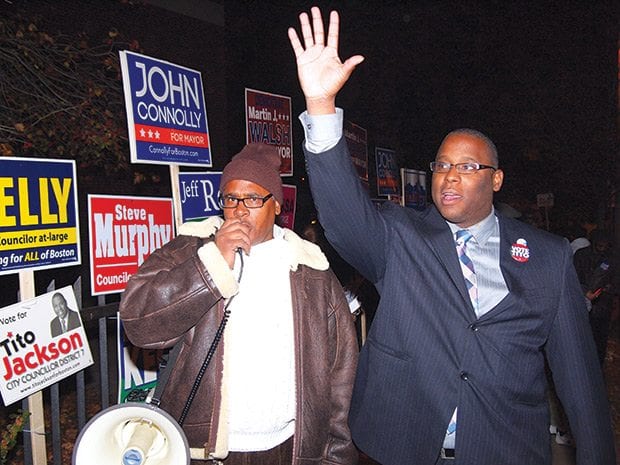
As political pundits begin analyzing the results of the election that propelled state Rep. Marty Walsh into the mayor’s office, it’s becoming clear that the traditional nexus of white liberals and people of color gave way to a new alliance between people of color and working-class whites.
“Both candidates were seen as progressive,” said blogger Benjamin Day, who posted an analysis of the mayoral and city council votes on the liberal Blue Mass Group website. “The race became about class.”
The divisions between Walsh and Connolly’s respective voter bases show up starkly on the jigsaw puzzle map of Boston’s wards and precincts, with the railroad tracks of the Southwest Corridor the most prominent line of demarcation. To the east, South Boston, Roxbury, Dorchester, Mattapan, Hyde Park and the more heavily Latino precincts in Jamaica Plain voted solidly with Walsh.
Voting for Connolly were the more affluent neighborhoods of Downtown, the Back Bay, Beacon Hill, the South End, the Pondside and Moss Hill sections of Jamaica Plain and West Roxbury.
The Walsh/Connolly divide continues southwest along Washington St. — all the way to a half-mile shy of the border of Dedham — with the relative income levels of the neighborhoods largely defining the split.
To the north, Massachusetts Ave. — the traditional boundary between Roxbury and the South End — stands as the border between Walsh and Connolly.
While Walsh won precincts in Jackson Square, Mission Hill and the Fenway, Ward 11, Precinct 1, a section of Fort Hill with high real estate values, stands as the sole outlier on the Roxbury side of the tracks, having delivered Connolly 52 percent of the vote.
The alignment of working-class whites and black voters may be the first instance in Boston’s history that the two, usually distinct voting blocs aligned.
“It’s quite a change,” said Bill Fletcher Jr., chairman of the board of directors at the International Labor Forum and a former Mattapan resident who worked on Mel King’s 1983 run for mayor against Ray Flynn — a race that cleaved neatly along race lines.
Fletcher, who now lives in the Washington D.C. area, likened Walsh’s win to progressive candidate Bill deBlasio’s victory in New York.
“I think we may very well be seeing the beginning of a pro-working people alliance taking shape,” he said.
But aside from a few smaller races — including a socialist candidate with nearly 50 percent of the city-wide vote in Seattle — there’s not enough evidence to declare an electoral trend, Fletcher cautioned.
“It’s a curiosity point, right now,” he said. “It’s something we should watch to see if it develops.”
The results of the Boston race were particularly unusual, Day points out, given that the votes for most at-large City Council candidates followed the familiar pattern — with voters in black and white liberal wards supporting Ayanna Pressley, a black woman, and voters in white, conservative-voting neighborhoods like South Boston, Neponset and West Roxbury supporting Michael Flaherty and Stephen Murphy, both of whom are white.
In Dorchester, where enclaves of conservative white voters do not commonly support the same candidates as the neighborhood’s black and Cape Verdean residents, the entire neighborhood voted for Walsh.
“All of Dorchester usually doesn’t vote together,” Day commented. “And usually JP doesn’t split.”
The end result of the class-based alliance was that Walsh was able to move the geographically confined base of support he relied on for his first-place finish in the preliminary west, capturing the city’s predominantly black and Latino wards. While turnout in those wards was low for a mayoral race — ranging from 30 percent to 35 percent, both Walsh and Connolly mounted aggressive get-out-the-vote efforts to bring supporter to the polls.
Citywide, turnout averaged 38 percent.
With both candidates taking identical stands on issues including charter schools, diversity in city government and leveraging city resources to build more affordable housing, the choice for many voters may have come down to whether or not voters were comfortable with Walsh’s 20-year background as a union leader, or whether they were swayed by attack ads, paid for by an AFL-CIO organization, painting the Harvard-educated Connolly as an elitist.
Another factor in the predominantly black, Latino and Asian communities may have been the endorsements of black elected officials, all of which went to Walsh. Additionally, Walsh benefitted from the endorsements of formal rivals in the mayoral race, Felix G. Arroyo, John Barros and Charlotte Golar Richie.
But voter Linda Gibson, who works in a Boston hospital, said she made up her mind after watching a televised debate.
Observers said the three candidates actively campaigned for Walsh. Golar Richie and Arroyo worked out of campaign offices and marshaled volunteers to work for the Walsh campaign, phone-banking, door-knocking and offering Walsh supporters rides to the polls.
“Neither one really impressed me much,” Gibson said in an interview outside the Lewis/Higginson School in Roxbury’s Ward 12. “Out of the two, I liked Marty Walsh better. I got better vibes from him.”
Now, as Walsh confronts the challenge of governing Boston, observers will be able to discern whether the new alliance of white and black voters has substance, according to Fletcher.
“The question that will emerge is to what extent will [Walsh] address race issues directly,” he said. “The question is whether we’ll see a progressive bloc that addresses equality.”







